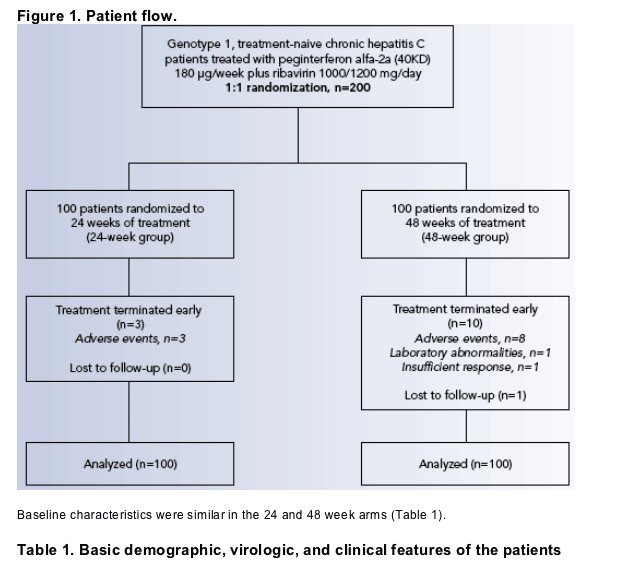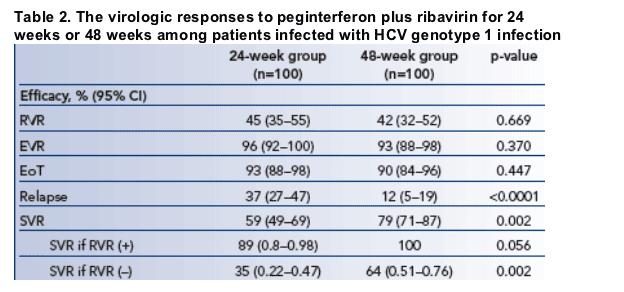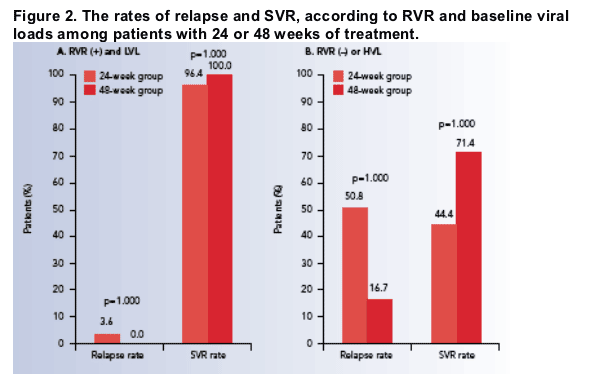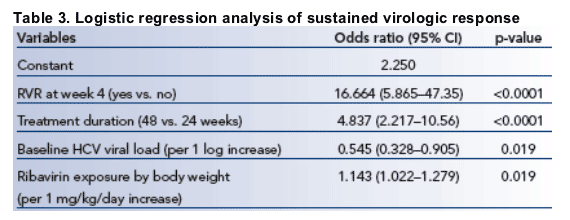 |
 |
 |
| |
High chance of cure in HCV genotype 1 patients with a low viral load achieving an RVR treated for 24 weeks with pegylated
interferon alfa-2a (PEGASYS) plus ribavirin (COPEGUS): prospective, randomized, controlled study comparing 24 & 48 weeks of treatment
|
| |
| |
Reported by Jules Levin
AASLD, Nov 2-6, 2007, Boston, MA
M.-L. Yu,1,2 C.-Y. Dai,1,2,3 J.-F. Huang,4 L.-P. Lee,1 M.-Y. Hsieh,1 C.-F. Chiu,5 N.-J. Hou,4 Z.-Y. Lin,1,2 S.-C. Chen,1,2 M.-Y. Hsieh,1,2 L.-Y. Wang,1,2 W.-Y. Chang,1,2 and W.-L. Chuang1,2
1Hepatobiliary Division, Faculty of Internal Medicine, College of Medicine, Kaohsiung Medical University, Kaohsiung, Taiwan; 2Hepatobiliary Division, Department of Internal Medicine, Kaohsiung Medical University Hospital, Kaohsiung, Taiwan;
3Department of Internal Medicine, Kaohsiung Municipal Hsiao-Kang Hospital, Kaohsiung, Taiwan; 4Department of Internal Medicine, Foo Yin Hospital, Pintung, Taiwan; 5Department of Internal Medicine, Paochien Hospital, Pintung, Taiwan
CONCLUSIONS
This study demonstrated that a shorter course of 24-week peginterferon alfa-2a (40KD) plus weight-based ribavirin 1000/1200 mg/day was as effective as a standard 48-week course in patients chronically infected with HCV genotype 1 who had a low baseline viral load (LVL) and achieved an RVR at week 4.
In patients that do not achieve an RVR or have high baseline viral loads (HVL) 48 weeks of therapy with peginterferon alfa-2a still provides the best likelihood of an SVR.
MLR analyses confirmed that achieving an RVR at week 4 is the single best predictor significantly affecting SVR in both 24- and 48-week groups.
Our results provide information necessary for decision-making of individualized treatment based on response at 4 weeks and baseline viral loads in chronic hepatitis C patients with HCV genotype 1 infections.
INTRODUCTION
Peginterferon and ribavirin combination treatment has been recommended for all patients infected with HCV, but the treatment duration varies depending on the HCV genotype. Recommended treatment for patients with HCV genotype 1 (G1) infection is pegylated interferon plus ribavirin (RBV) for 48 weeks and 24 weeks for HCV G2/3.[1,2] A rapid virologic response (RVR; <50 IU/mL HCV RNA at week 4) is a strong predictor of sustained virologic response (SVR; <50 IU/mL HCV RNA 24 weeks after untreated follow-up).[3,4] SVR rates of >80% with a shorter treatment duration of 12-16 weeks pegylated interferon alfa-2a (40KD) plus RBV in HCV G2/3 patients with an RVR[5-7] have questioned whether shorter treatment durations can yield high SVR rates for G1 patients with an RVR.
OBJECTIVES
The primary aim of the present study was to evaluate whether treatment with peginterferon and ribavirin for 24 weeks is sufficient to achieve an SVR rate comparable to that observed with the standard treatment duration of 48 weeks, in HCV genotype 1 patients achieving an RVR at 4 weeks.
The secondary aim was to investigate the role of on-treatment virologic responses among patients with 24 or 48 weeks of treatment.
METHODS
Randomized, open-label, active-controlled trial carried out in one medical center and three regional core hospitals in Taiwan from April 2005 to May 2007.
Patients
Eligible subjects were treatment-naive, Taiwanese patients with confirmed chronic hepatitis C (genotype 1) aged 18 to 65 years old. Patients displayed elevated serum alanine aminotransferase (ALT) levels for at least two measurements within 6 months preceding trial entry.
Other eligibility criteria included neutrophil count >1500/mm3, platelet count
>9 -104/mm3, hemoglobin level >12 g/dL for men and >11 g/dL for women, serum creatinine level <1.5 mg/dL, no pregnancy or lactation, and the use of a reliable method of contraception.
Exclusion criteria included patients with detectable hepatitis B surface antigen, HIV infection, autoimmune hepatitis, primary biliary cirrhosis, sclerosing cholangitis, Wilson disease, a1-antitrypsin deficiency, decompensated cirrhosis (Child-Pugh class B or C), overt hepatic failure, a current or past history of alcohol abuse (≥20 g daily), psychiatric condition, previous liver transplantation, or evidence of hepatocellular carcinoma.
Treatment
Patients were randomized (1:1) to 24 weeks or 48 weeks peginterferon alfa-2a (40KD) (PEGASYS, Roche, NJ, USA) 180 _g/week plus ribavirin (COPEGUS, Roche, NJ, USA) 1000/1200 mg/day, with a follow-up period of 24 weeks.
The dose modification of peginterferon and ribavirin was according to the strategy described previously.[7]
Adverse events were graded as mild, moderate, severe, or potentially life-threatening.
Serum HCV RNA levels at baseline and during treatment week 4 were measured
using the branched DNA assay (Versant HCV RNA 3.0, Bayer, Tarrytown, NJ, USA). Serum HCV RNA at baseline, during treatment weeks 4 and 12, at the end
of treatment, and at 24 weeks after therapy was determined by standardized
automated qualitative PCR.
Liver histology was graded and staged according to the scoring system described by Knodell and Scheuer by a single pathologist who was blinded to the treatment of each patient.
Outcomes
The primary end point of this study was to assess SVR, which was defined as PCR-negative serum HCV RNA (<50 IU/mL) by the end of treatment and
throughout the follow-up period.
RVR was defined as PCR-negative serum HCV RNA at 4 weeks of therapy.
Early virologic response (EVR) was defined as PCR-negative or at least 2 log10
decline from baseline of serum HCV RNA at 12 weeks of treatment.
End-of-treatment virologic response (EoT) was defined as PCR-negative serum HCV RNA at end of treatment.
Relapse was defined as HCV RNA reappearance during the follow-up period in
patients who achieved an end-of-treatment virologic response.
Statistical analyses
Evaluation of efficacy of antiviral treatment was based on an intention-to-treat (ITT) analysis. All patients receiving one treatment dose of peginterferon or ribavirin were analyzed.
Frequency was compared between groups using the X2 test, with the Yates correction, or Fisher exact test. Group means, presented as mean values ± standard deviation, were compared using analysis of variance and the Student t test, or nonparametric Mann-Whitney test when appropriate.
Serum HCV RNA levels were expressed after logarithmic transformation of original values.
Stepwise logistical regression was used to analyze which variables had a better
predictive value for SVR.
The procedures were performed using the SPSS 12.0 statistical package (SPSS,
Chicago, IL, USA). All statistical analyses were based on two-sided hypothesis tests with a significance level of p<0.05.
RESULTS
A total of 200 patients were randomized and 199 patients completed the study (Figure 1).
All patients were infected with genotype 1b.


Similar rates of RVR (45% and 42%) and EVR (96% and 93%) were observed for 24 and 48 weeks of therapy, respectively (Table 2).
Overall, the 48 week arm had a significantly lower relapse rate and a higher SVR rate than the 24 week arm (ITT).

Patients with an RVR had a significantly higher SVR rate than patients without an RVR in both treatment arms. Eighty-nine percent and 100% of patients who achieved an RVR achieved an SVR over 24 weeks and 48 weeks of therapy, respectively. Of patients who did not achieve an RVR, 35% and 64% of patients achieved an SVR over 24 weeks and 48 weeks of therapy, respectively (Table 2).
Among patients that at baseline demonstrated low viral load (LVL, <400 000 IU/mL) and achieved an RVR, the relapse rate and SVR rate in the 24-week group (3.6% and 96.4%, respectively) was comparable with responses seen in the 48-week group (0% and 100%, respectively) (Figure 2A).
Patients with an RVR had a significantly higher SVR rate than patients without an RVR in both treatment arms. Eighty-nine percent and 100% of patients who achieved an RVR achieved an SVR over 24 weeks and 48 weeks of therapy, respectively. Of patients who did not achieve an RVR, 35% and 64% of patients achieved an SVR over 24 weeks and 48 weeks of therapy, respectively (Table 2).
Among patients that at baseline demonstrated low viral load (LVL, <400 000 IU/mL) and achieved an RVR, the relapse rate and SVR rate in the 24-week group (3.6% and 96.4%, respectively) was comparable with responses seen in the 48-week group (0% and 100%, respectively) (Figure 2A).

Multiple logistic regression (MLR) analysis in all patients showed that an RVR was the strongest independent factor associated with achieving an SVR, followed by treatment duration, baseline viral load and ribavirin exposure (Table 3).

Safety
Two serious adverse events were reported: one patient in the 24-week arm
experienced varices bleeding at the end-of-treatment; 1 patient in the 48-week arm suffered from severe lumbago with mild disability during treatment but recovered after 5 days in-patient care.
Three patients in the 24-week arm discontinued treatment due to adverse events,
compared with 10 patients in the 48-week arm who discontinued treatment due to adverse events (n=8), increased serum creatinine level (n=1) and insufficient
response (n=1).
The rates of dose modification or transient interruption of peginterferon and/or
ribavirin, gastrointestinal, psychiatric, dermatological and hematological symptoms and thyroid dysfunction tended to be higher in the 48-week than in the 24-week arm. However, the difference did not reach statistical significance. The 48-week arm had a significantly higher rate of discontinuation than the 24-week arm.
REFERENCES
1. Strader DB, Wright T, Thomas DL, et al. Diagnosis, management, and treatment of hepatitis C. Hepatology 2004; 39:1147-1171.
2. National Institutes of Health. National Institutes of Health Consensus Development Conference Statement: Management of hepatitis C: 2002, June 10-12, 2002. Hepatology 2002; 36: S3-20.
3. Jensen DM, Morgan TR, Marcellin P, et al. Early identification of HCV genotype 1 patients responding to 24 weeks peginterferon alpha-2a (40 KD)/ribavirin therapy. Hepatology 2006; 43: 954-960.
4. Yu ML, Chuang WL, Dai CY, et al. Different viral kinetics between hepatitis C virus genotype 1 and
2 as on-treatment predictors of response to a 24-week course of high-dose interferon-alpha plus ribavirin combination therapy. Transl Res 2006; 148:120-127.
5. Dalgard O, Bjoro K, Hellum KB, et al. Treatment with pegylated interferon and ribavarin in HCV infection with genotype 2 or 3 for 14 weeks: a pilot study. Hepatology 2004; 40:1260-1265.
6. von Wagner M, Huber M, Berg T, et al. Peginterferon-alpha-2a (40KD) and ribavirin for 16 or 24 weeks in patients with genotype 2 or 3 chronic hepatitis C. Gastroenterology 2005; 129: 522-527.
7. Yu ML, Dai CY, Huang JF, et al. A randomised study of peginterferon and ribavirin for 16 versus 24 weeks in patients with genotype 2 chronic hepatitis C. Gut 2007; 56: 553-559.
|
| |
|
 |
 |
|
|